Systematic Review of the Literature to Inform the Development of a South African Dietary Polyphenol Composition Database
Abstract
1. Introduction
2. Materials and Methods
2.1. Search Strategy
2.2. Eligibility Screening
2.3. Data Extraction and Analysis
3. Results
3.1. Study Selection
3.2. Year of Publication
3.3. Data Sources
3.4. Geographical Distribution of Included Studies
3.5. Food Groups, Food Items and Total Polyphenols
3.6. Polyphenol Class and Subclass
3.7. Polyphenol Quantification Methods
4. Discussion
5. Conclusions
Author Contributions
Funding
Institutional Review Board Statement
Informed Consent Statement
Data Availability Statement
Acknowledgments
Conflicts of Interest
References
- World Health Organization. Noncommunicable Diseases Progress Monitor 2022; World Health Organization: Geneva, Switzerland, 2022. [Google Scholar]
- Statistics South Africa. Mortality and Causes of Death in South Africa, 2018: Findings from Death Notification; Statistics South Africa: Pretoria, South Africa, 2018; pp. 1–149. [Google Scholar]
- Swart, R. Executive Summary in Foods Procured, Nutritional Status and Dietary Intake of People Living in South Africa: Desktop Review; National Department of Health, South Africa & DSI-NRF Center of Excellence in Food Security: Pretoria, South Africa, 2022; pp. 1–408. [Google Scholar]
- Unilever Food Solutions. Plate of the Nation. Available online: https://www.unileverfoodsolutions.co.za/chef-inspiration/all-themes/inspiration-from-our-brands/Knorr/plate-of-the-nation.html (accessed on 15 November 2022).
- National Department of Health South Africa. The National Strategic Plan for the Prevention and Control of Non-Communicable Diseases, 2022–2027; National Department of Health: Pretoria, South Africa, 2022; pp. 1–55. [Google Scholar]
- Vorster, H.H.; Badham, J.; Venter, C. An introduction to the revised food-based dietary guidelines for South Africa. S. Afr. J. Clin. Nutr. 2013, 26, S5–S12. [Google Scholar]
- Department of Basic Education South Africa. National School Nutrition Programme: Guidelines for Tuck Shop Operators; Department of Basic Education: Pretoria, South Africa, 2014; pp. 1–20. [Google Scholar]
- Aune, D.; Giovannucci, E.; Boffetta, P.; Fadnes, L.T.; Keum, N.; Norat, T.; Greenwood, D.C.; Riboli, E.; Vatten, L.J.; Tonstad, S. Fruit and vegetable intake and the risk of cardiovascular disease, total cancer and all-cause mortality—A systematic review and dose-response meta-analysis of prospective studies. Int. J. Epidemiol. 2017, 46, 1029–1056. [Google Scholar] [CrossRef] [PubMed]
- Jiang, X.; Huang, J.; Song, D.; Deng, R.; Wei, J.; Zhang, Z. Increased consumption of fruit and vegetables is related to a reduced risk of cognitive impairment and dementia: Meta-analysis. Front. Aging Neurosci. 2017, 9, 18. [Google Scholar] [CrossRef] [PubMed]
- Li, M.; Fan, Y.; Zhang, X.; Hou, W.; Tang, Z. Fruit and vegetable intake and risk of type 2 diabetes mellitus: Meta-analysis of prospective cohort studies. BMJ Open 2014, 4, e005497. [Google Scholar] [CrossRef]
- Tsao, R. Chemistry and biochemistry of dietary polyphenols. Nutrients 2010, 2, 1231–1246. [Google Scholar] [CrossRef]
- Pérez-Jiménez, J.; Neveu, V.; Vos, F.; Scalbert, A. Identification of the 100 richest dietary sources of polyphenols: An application of the Phenol-Explorer database. Eur. J. Clin. Nutr. 2010, 64, S112–S120. [Google Scholar] [CrossRef]
- Mchiza, Z.J.; Steyn, N.P.; Hill, J.; Kruger, A.; Schönfeldt, H.; Nel, J.; Wentzel-Viljoen, E. A Review of Dietary Surveys in the Adult South African Population from 2000 to 2015. Nutrients 2015, 7, 8227–8250. [Google Scholar] [CrossRef]
- Neveu, V.; Perez-Jiménez, J.; Vos, F.; Crespy, V.; du Chaffaut, L.; Mennen, L.; Knox, C.; Eisner, R.; Cruz, J.; Wishart, D. Phenol-Explorer: An online comprehensive database on polyphenol contents in foods. Database 2010, 2010, bap024. [Google Scholar] [CrossRef]
- Quiñones, M.; Miguel, M.; Aleixandre, A. Beneficial effects of polyphenols on cardiovascular disease. Pharmacol. Res. 2013, 68, 125–131. [Google Scholar] [CrossRef]
- Domínguez Avila, J.A.; Rodrigo García, J.; González Aguilar, G.A.; De la Rosa, L.A. The antidiabetic mechanisms of polyphenols related to increased glucagon-like peptide-1 (GLP1) and insulin signaling. Molecules 2017, 22, 903. [Google Scholar] [CrossRef]
- Dai, J.; Mumper, R.J. Plant phenolics: Extraction, analysis and their antioxidant and anticancer properties. Molecules 2010, 15, 7313–7352. [Google Scholar] [CrossRef] [PubMed]
- Lambert, J.D.; Hong, J.; Yang, G.-y.; Liao, J.; Yang, C.S. Inhibition of carcinogenesis by polyphenols: Evidence from laboratory investigations. Am. J. Clin. Nutr. 2005, 81, 284S–291S. [Google Scholar] [CrossRef] [PubMed]
- Igwe, E.; Neale, E.; Charlton, K.E.; Morton, K.; Probst, Y.C. First stage development of an Australian anthocyanin food composition database for dietary studies—A systematic process and its challenges. J. Food Compos. Anal. 2017, 64, 33–38. [Google Scholar] [CrossRef]
- SAFOODS-South African Food Data System. SAFOODS: South African Food Data System. Available online: https://safoods.mrc.ac.za/ (accessed on 12 September 2022).
- Probst, Y.; Guan, V.; Kent, K. A systematic review of food composition tools used for determining dietary polyphenol intake in estimated intake studies. Food Chem. 2018, 238, 146–152. [Google Scholar] [CrossRef]
- Moher, D.; Liberati, A.; Tetzlaff, J.; Altman, D.G.; PRISMA Group. Preferred reporting items for systematic reviews and meta-analyses: The PRISMA statement. Ann. Intern. Med. 2009, 151, 264–269. [Google Scholar] [CrossRef]
- Ouzzani, M.; Hammady, H.; Fedorowicz, Z.; Elmagarmid, A. Rayyan—A web and mobile app for systematic reviews. Syst. Rev. 2016, 5, 210. [Google Scholar] [CrossRef]
- Explorer, P. Phenol-Explorer: Database on Polyphenol Content in Foods. Available online: http://phenol-explorer.eu/ (accessed on 18 October 2022).
- Ignat, I.; Volf, I.; Popa, V.I. A critical review of methods for characterisation of polyphenolic compounds in fruits and vegetables. Food Chem. 2011, 126, 1821–1835. [Google Scholar] [CrossRef]
- Church, S. EuroFIR synthesis report No 7: Food composition explained. Nutr. Bull. 2009, 34, 250–272. [Google Scholar] [CrossRef]
- Pennington, J.A. Applications of food composition data: Data sources and considerations for use. J. Food Compos. Anal. 2008, 21, S3–S12. [Google Scholar] [CrossRef]
- Elmadfa, I.; Meyer, A.L. Importance of food composition data to nutrition and public health. Eur. J. Clin. Nutr. 2010, 64, S4–S7. [Google Scholar] [CrossRef]
- Greenfield, H.; Southgate, D.A. Food Composition Data: Production, Management, and Use; Food and Agriculture Organization: Rome, Italy, 2003. [Google Scholar]
- Bhagwat, S.; Haytowitz, D.B.; Holden, J.M. USDA Database for the Flavonoid Content of Selected Foods, Release 3; United States Department of Agriculture: Washington, DC, USA, 2011. Available online: http://www.ars.usda.gov/nutrientdata/flav (accessed on 19 September 2022).
- Del Bό, C.; Bernardi, S.; Marino, M.; Porrini, M.; Tucci, M.; Guglielmetti, S.; Cherubini, A.; Carrieri, B.; Kirkup, B.; Kroon, P. Systematic review on polyphenol intake and health outcomes: Is there sufficient evidence to define a health-promoting polyphenol-rich dietary pattern? Nutrients 2019, 11, 1355. [Google Scholar] [CrossRef]
- Plumb, J.; Lyons, J.; Nørby, K.; Thomas, M.; Nørby, E.; Poms, R.; Bucchini, L.; Restani, P.; Kiely, M.; Finglas, P. ePlantLIBRA: A composition and biological activity database for bioactive compounds in plant food supplements. Food Chem. 2016, 193, 121–127. [Google Scholar] [CrossRef] [PubMed]
- Lavis, J.N. Moving forward on both systematic reviews and deliberative processes. Healthc. Policy 2006, 1, 59. Available online: http://www.ncbi.nlm.nih.gov/pmc/articles/pmc2585328/ (accessed on 23 August 2022). [CrossRef] [PubMed]
- Lichtenstein, A.H.; Yetley, E.A.; Lau, J. Application of systematic review methodology to the field of nutrition. J. Nutr. 2008, 138, 2297–2306. [Google Scholar] [CrossRef]
- Defago, M.D.; Bardach, A.E.; Levy, L.Y.; Irazola, V.E.; Comande, D.; Rubinstein, A.L.; Balaciano, G.; Nessier, M.C.; Elorriaga, N. Food composition data in Argentina: A systematic review of the literature. J. Food Compos. Anal. 2015, 43, 39–48. [Google Scholar] [CrossRef]
- Wood, A.; Baxter, G.; Thies, F.; Kyle, J.; Duthie, G. A systematic review of salicylates in foods: Estimated daily intake of a Scottish population. Mol. Nutr. Food Res. 2011, 55, S7–S14. [Google Scholar] [CrossRef] [PubMed]
- Lefebvre, C.; Manheimer, E.; Glanville, J. Searching for studies. In Cochrane Handbook for Systematic Reviews of Interventions Version 5.1.0; Updated March 2011; Higgins, J.P., Green, S., Eds.; John Wiley & Sons Ltd.: West Sussex, UK, 2011; pp. 95–150. [Google Scholar]
- Statistics South Africa. Census of Commercial Agriculture 2017; Statistics South Africa: Pretoria, South Africa, 2020; pp. 1–104. [Google Scholar]
- Nogata, Y.; Sakamoto, K.; Shiratsuchi, H.; Ishii, T.; Yano, M.; Ohta, H. Flavonoid composition of fruit tissues of citrus species. Biosci. Biotechnol. Biochem. 2006, 70, 178–192. [Google Scholar] [CrossRef]
- Sellamuthu, P.S.; Mafune, M.; Sivakumar, D.; Soundy, P. Thyme oil vapour and modified atmosphere packaging reduce anthracnose incidence and maintain fruit quality in avocado. J. Sci. Food Agric. 2013, 93, 3024–3031. [Google Scholar] [CrossRef]
- Yang, Z.; Shi, L.; Qi, Y.; Xie, C.; Zhao, W.; Barrow, C.J.; Dunshea, F.R.; Suleria, H.A.R. Effect of processing on polyphenols in butternut pumpkin (Cucurbita moschata). Food Biosci. 2022, 49, 101925. [Google Scholar] [CrossRef]
- South African Weather Service. Annual State of the Climate of South Africa 2022; South African Weather Service: Pretoria, South Africa, 2023; pp. 1–30. [Google Scholar]
- Wines of South Africa. The Industry Overview. Available online: https://www.wosa.co.za/The-Industry/Overview/ (accessed on 5 January 2023).
- Statistics South Africa. Mid-Year Population Estimates of 2022; Statistics South Africa: Pretoria, South Africa, 2022. [Google Scholar]
- Beelders, T.; Sigge, G.O.; Joubert, E.; de Beer, D.; de Villiers, A. Kinetic optimisation of the reversed phase liquid chromatographic separation of rooibos tea (Aspalathus linearis) phenolics on conventional high performance liquid chromatographic instrumentation. J. Chromatogr. A 2012, 1219, 128–139. [Google Scholar] [CrossRef]
- Marnewick, J.L. Antioxidant Properties of Rooibos (Aspalathus linearis)—In Vitro and In Vivo Evidence. In Systems Biology of Free Radicals and Antioxidants; Springer: Berlin/Heidelberg, Germany, 2014; pp. 4083–4108. [Google Scholar] [CrossRef]
- Piek, H.; Venter, I.; Rautenbach, F.; Marnewick, J.L. Rooibos herbal tea: An optimal cup and its consumers. Health SA Gesondheid (Online) 2019, 24, 1–9. [Google Scholar] [CrossRef]
- Pezet, R.; Cuenat, P. Resveratrol in wine: Extraction from skin during fermentation and post-fermentation standing of must from Gamay grapes. Am. J. Enol. Vitic. 1996, 47, 287–290. [Google Scholar] [CrossRef]
- Vincenzi, S.; Tomasi, D.; Gaiotti, F.; Lovat, L.; Giacosa, S.; Torchio, F.; Segade, S.R.; Rolle, L. Comparative study of the resveratrol content of twenty-one Italian red grape varieties. S. Afr. J. Enol. Vitic. 2013, 34, 30–35. [Google Scholar] [CrossRef]
- Fruit South Africa. Fruit South Africa Annual Report 2020/2021; Fruit South Africa: Pretoria, South Africa, 2021; pp. 1–24. [Google Scholar]
- Kucich, D.A.; Wicht, M.M. South African indigenous fruits–Underutilized resource for boosting daily antioxidant intake among local indigent populations? S. Afr. J. Clin. Nutr. 2016, 29, 150–156. [Google Scholar] [CrossRef]
- Maphosa, Y.; Jideani, V.A. The role of legumes in human nutrition. In Functional Food-Improve Health through Adequate Food; Hueda, M.C., Ed.; IntechOpen: London, UK, 2017; Volume 1, p. 13. [Google Scholar]
- Nicolás-García, M.; Jiménez-Martínez, C.; Perucini-Avendaño, M.; Camacho-Díaz, B.H.; Jiménez-Aparicio, A.R.; Dávila-Ortiz, G. Phenolic Compounds in Legumes: Composition, Processing and Gut Health. In Legumes Research; Jimenez-Lopez, J.C., Ed.; IntechOpen: London, UK, 2021; Volume 2. [Google Scholar] [CrossRef]
- Tian, S.; Sun, Y.; Chen, Z.; Yang, Y.; Wang, Y. Functional properties of polyphenols in grains and effects of physicochemical processing on polyphenols. J. Food Qual. 2019, 2019, 2793973. [Google Scholar] [CrossRef]
- Vidal-Casanella, O.; Arias-Alpizar, K.; Núñez, O.; Saurina, J. Extraction and Characterization of Flavanol-Rich Nutraceuticals Based on High-Performance Liquid Chromatography. Separations 2022, 9, 87. [Google Scholar] [CrossRef]
- Oseredczuk, M.; Salvini, S.; Roe, M.; Møller, A. EuroFIR Work Package 1.3, Task Group 4 Guidelines for Quality Index Attribution to Original Data from Scientific Literature or Reports for EuroFIR Data Interchange; European Food Information Resource: Brussels, Belgium, 2008; Available online: https://www.eurofir.org/guidelines-for-quality-index-attribution-to-original-data-from-scientific-literature-or-reports-for-eurofir-data-interchange/ (accessed on 15 July 2022).
- Holden, J.M.; Bhagwat, S.A.; Haytowitz, D.B.; Gebhardt, S.E.; Dwyer, J.T.; Peterson, J.; Beecher, G.R.; Eldridge, A.L.; Balentine, D. Development of a database of critically evaluated flavonoids data: Application of USDA’s data quality evaluation system. J. Food Compos. Anal. 2005, 18, 829–844. [Google Scholar] [CrossRef]
- Holden, J.M.; Bhagwat, S.A.; Patterson, K.Y. Development of a multi-nutrient data quality evaluation system. J. Food Compos. Anal. 2002, 15, 339–348. [Google Scholar] [CrossRef]
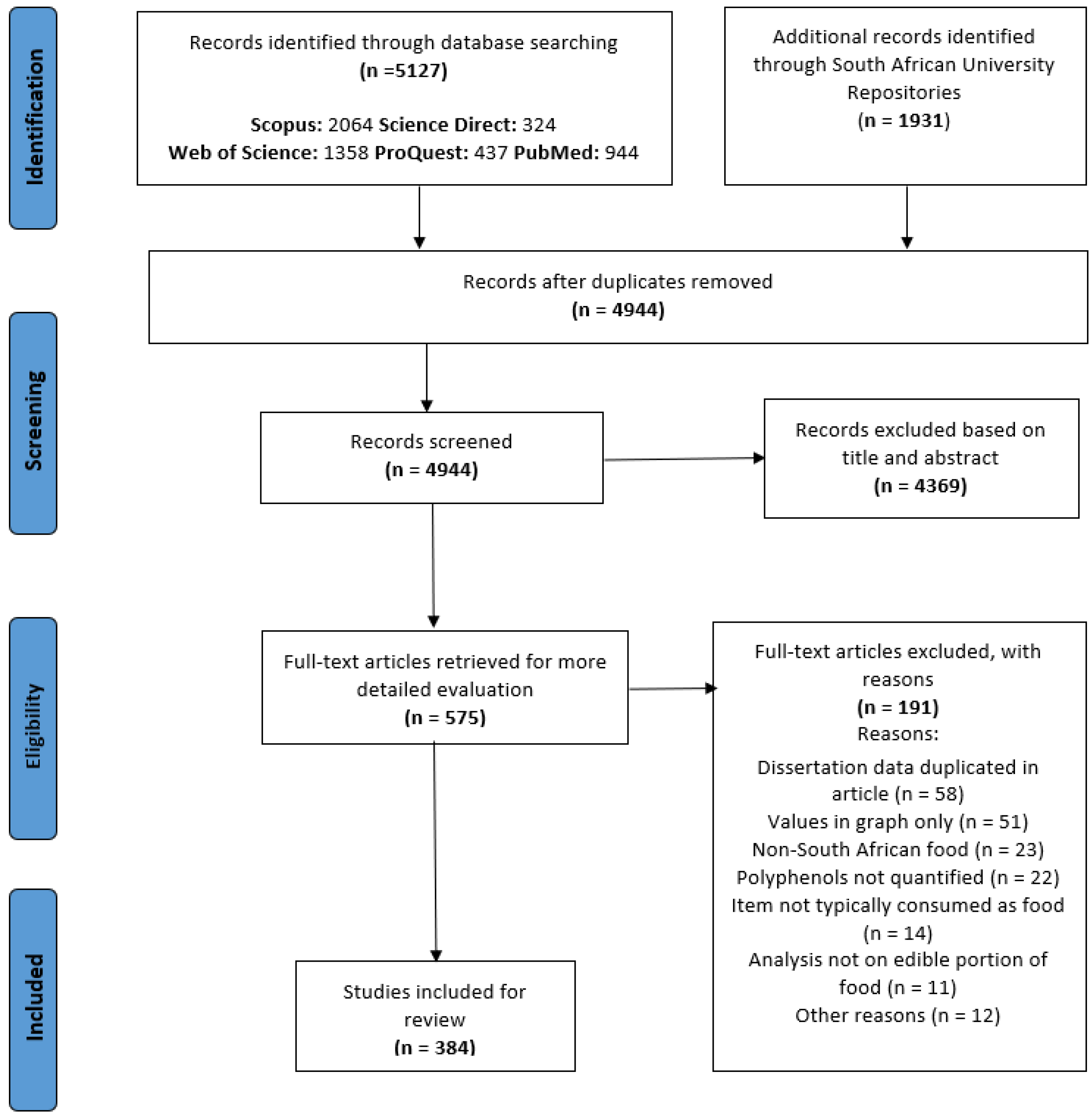
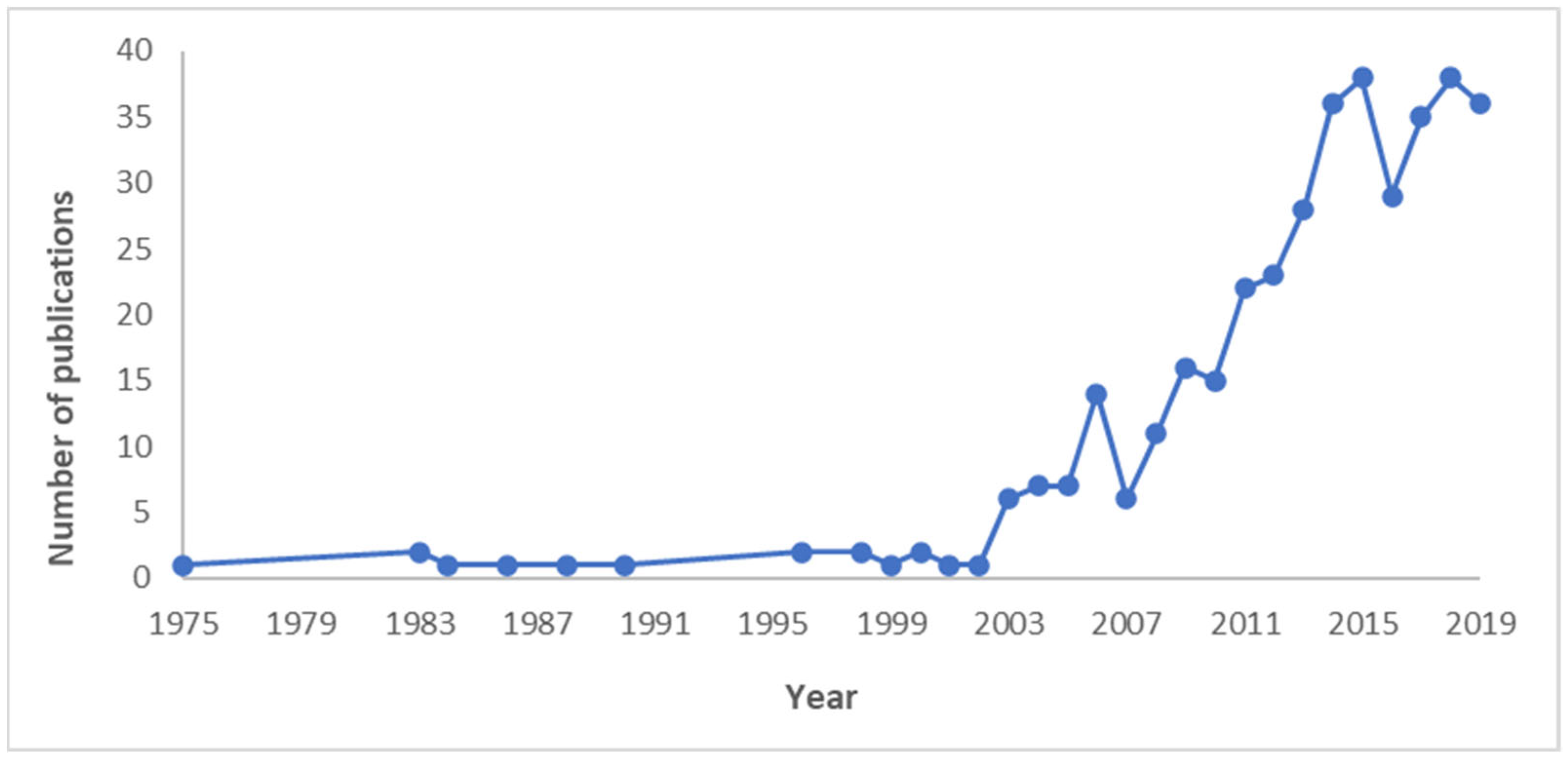
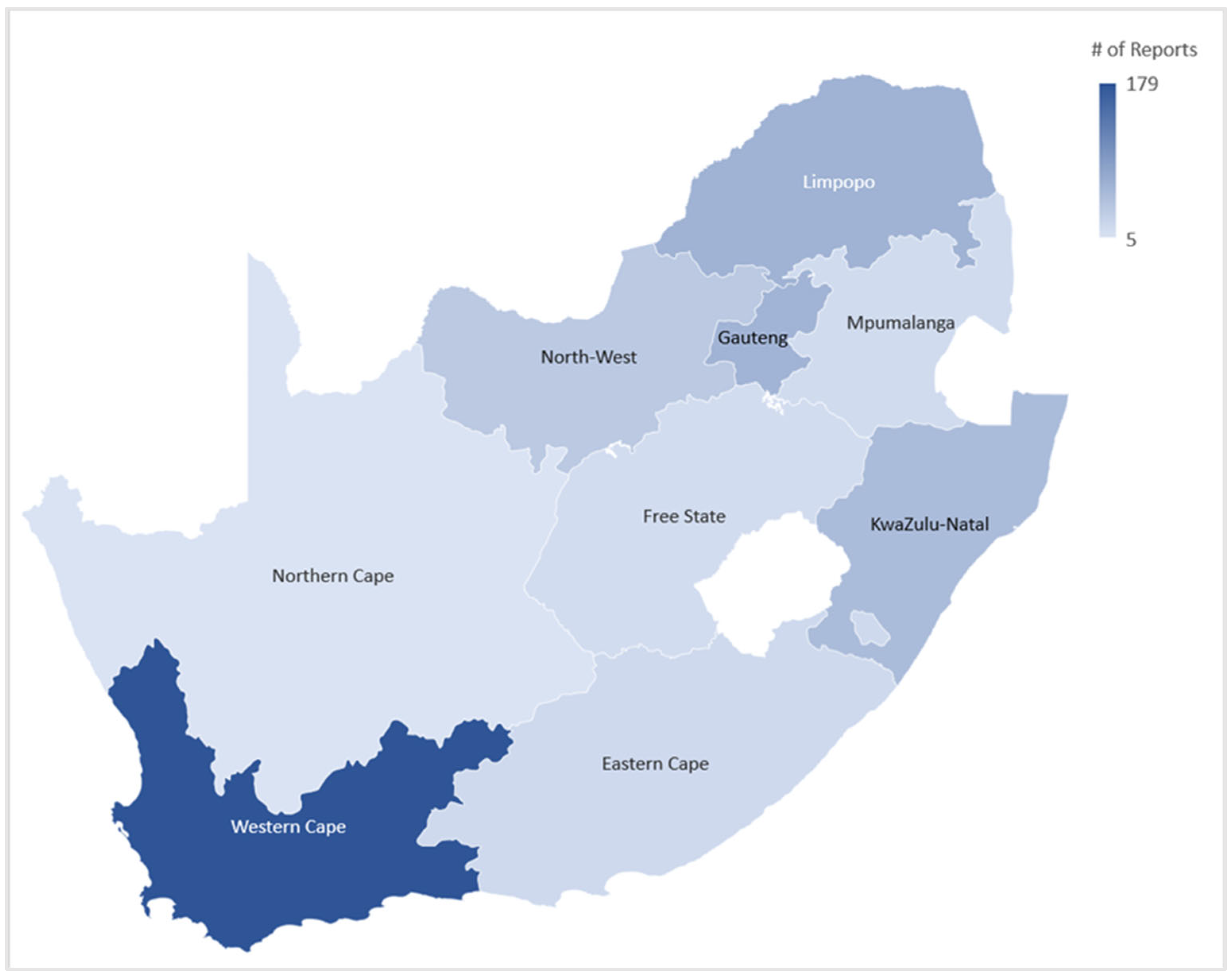
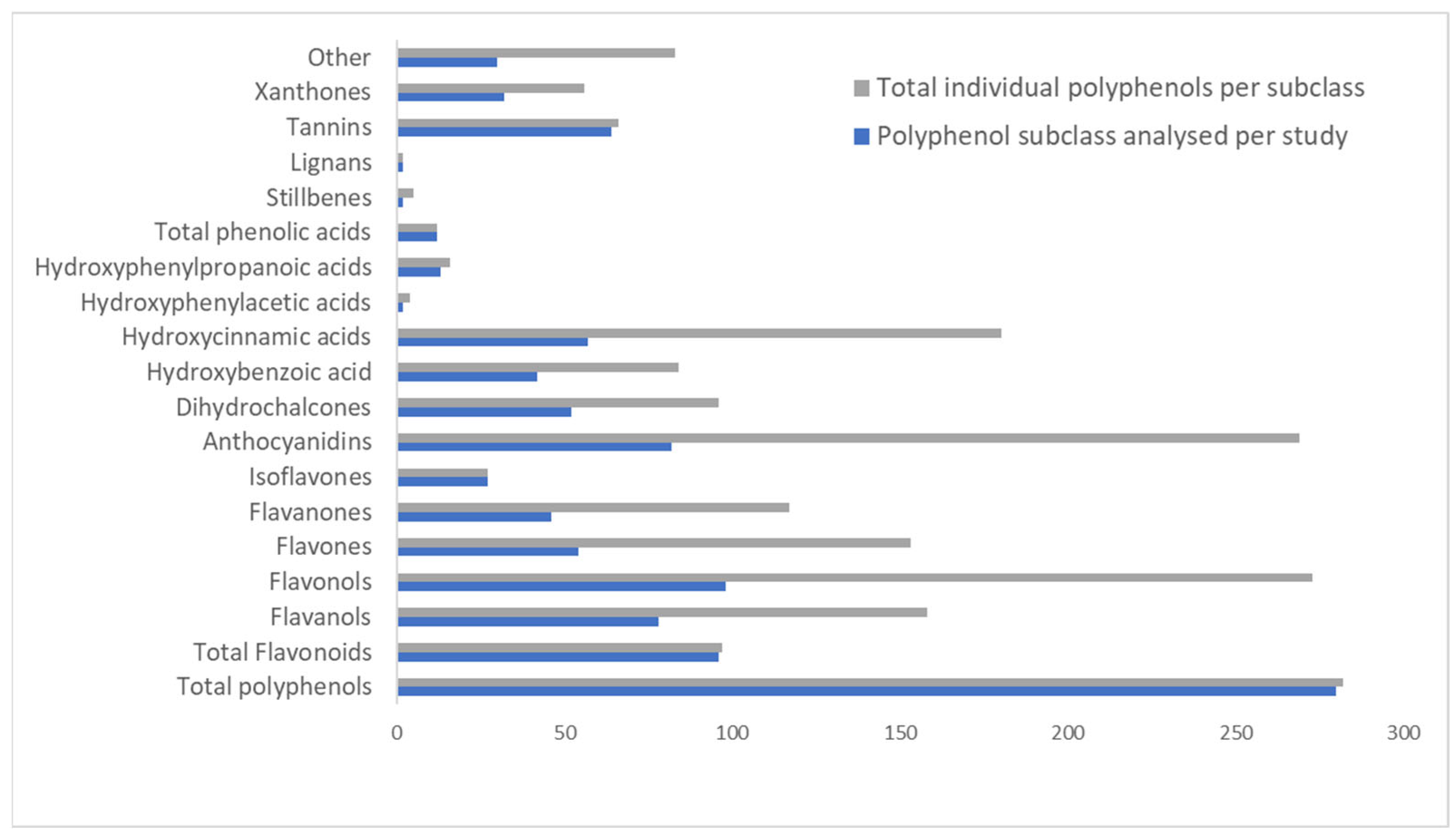
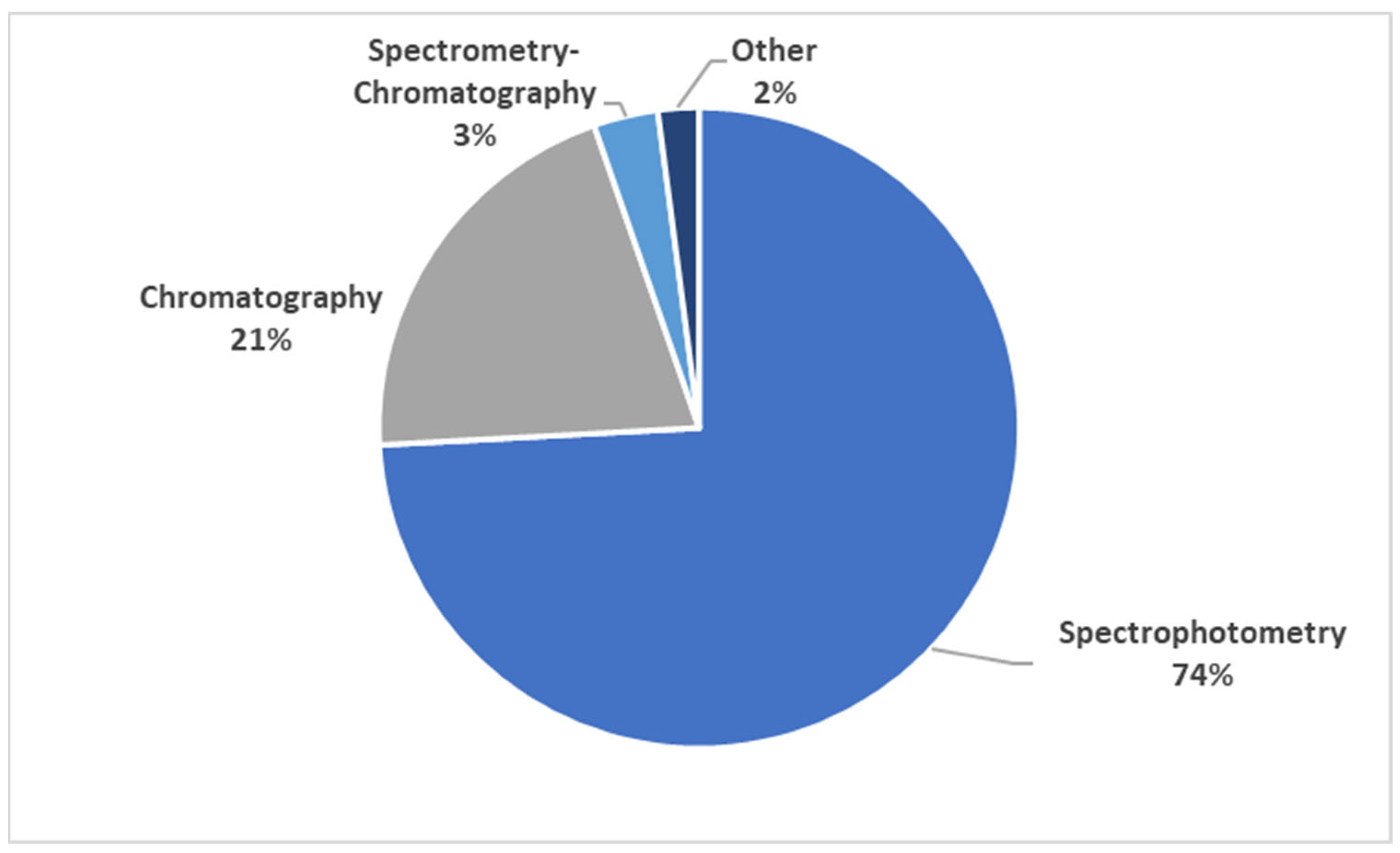
| University | Theses/Dissertations Included |
|---|---|
| Stellenbosch University | 59 |
| University of Pretoria | 31 |
| University of KwaZulu Natal | 18 |
| Cape Peninsula University of Technology | 17 |
| Tshwane University of Technology | 7 |
| University of Limpopo | 6 |
| Durban University of Technology | 5 |
| North-West University | 4 |
| University of Johannesburg | 4 |
| University of the Western Cape | 4 |
| University of South Africa | 3 |
| University of Zululand | 3 |
| University of Venda | 2 |
| Central University of Technology | 1 |
| University of Cape Town | 1 |
| University of Fort Hare | 1 |
| Food Group | Number of Food Items | Number of Polyphenols |
|---|---|---|
| Miscellaneous | 383 | 2482 |
| Vegetables | 187 | 458 |
| Fruit | 163 | 839 |
| Cereal and cereal products | 145 | 432 |
| Legumes and legume products | 75 | 508 |
| Beverages | 74 | 213 |
| Soups, sauces, seasonings and flavourings | 17 | 32 |
| Fats and oils | 11 | 11 |
| Nuts and seeds | 10 | 12 |
| Sugar, syrups and sweets | 3 | 5 |
| Meat and meat products | 1 | 1 |
| Milks and milk products | 1 | 1 |
| Total | 1070 | 4994 |
Disclaimer/Publisher’s Note: The statements, opinions and data contained in all publications are solely those of the individual author(s) and contributor(s) and not of MDPI and/or the editor(s). MDPI and/or the editor(s) disclaim responsibility for any injury to people or property resulting from any ideas, methods, instructions or products referred to in the content. |
© 2023 by the authors. Licensee MDPI, Basel, Switzerland. This article is an open access article distributed under the terms and conditions of the Creative Commons Attribution (CC BY) license (https://creativecommons.org/licenses/by/4.0/).
Share and Cite
Jumat, M.; Duodu, K.G.; van Graan, A. Systematic Review of the Literature to Inform the Development of a South African Dietary Polyphenol Composition Database. Nutrients 2023, 15, 2426. https://doi.org/10.3390/nu15112426
Jumat M, Duodu KG, van Graan A. Systematic Review of the Literature to Inform the Development of a South African Dietary Polyphenol Composition Database. Nutrients. 2023; 15(11):2426. https://doi.org/10.3390/nu15112426
Chicago/Turabian StyleJumat, Malory, Kwaku Gyebi Duodu, and Averalda van Graan. 2023. "Systematic Review of the Literature to Inform the Development of a South African Dietary Polyphenol Composition Database" Nutrients 15, no. 11: 2426. https://doi.org/10.3390/nu15112426
APA StyleJumat, M., Duodu, K. G., & van Graan, A. (2023). Systematic Review of the Literature to Inform the Development of a South African Dietary Polyphenol Composition Database. Nutrients, 15(11), 2426. https://doi.org/10.3390/nu15112426






